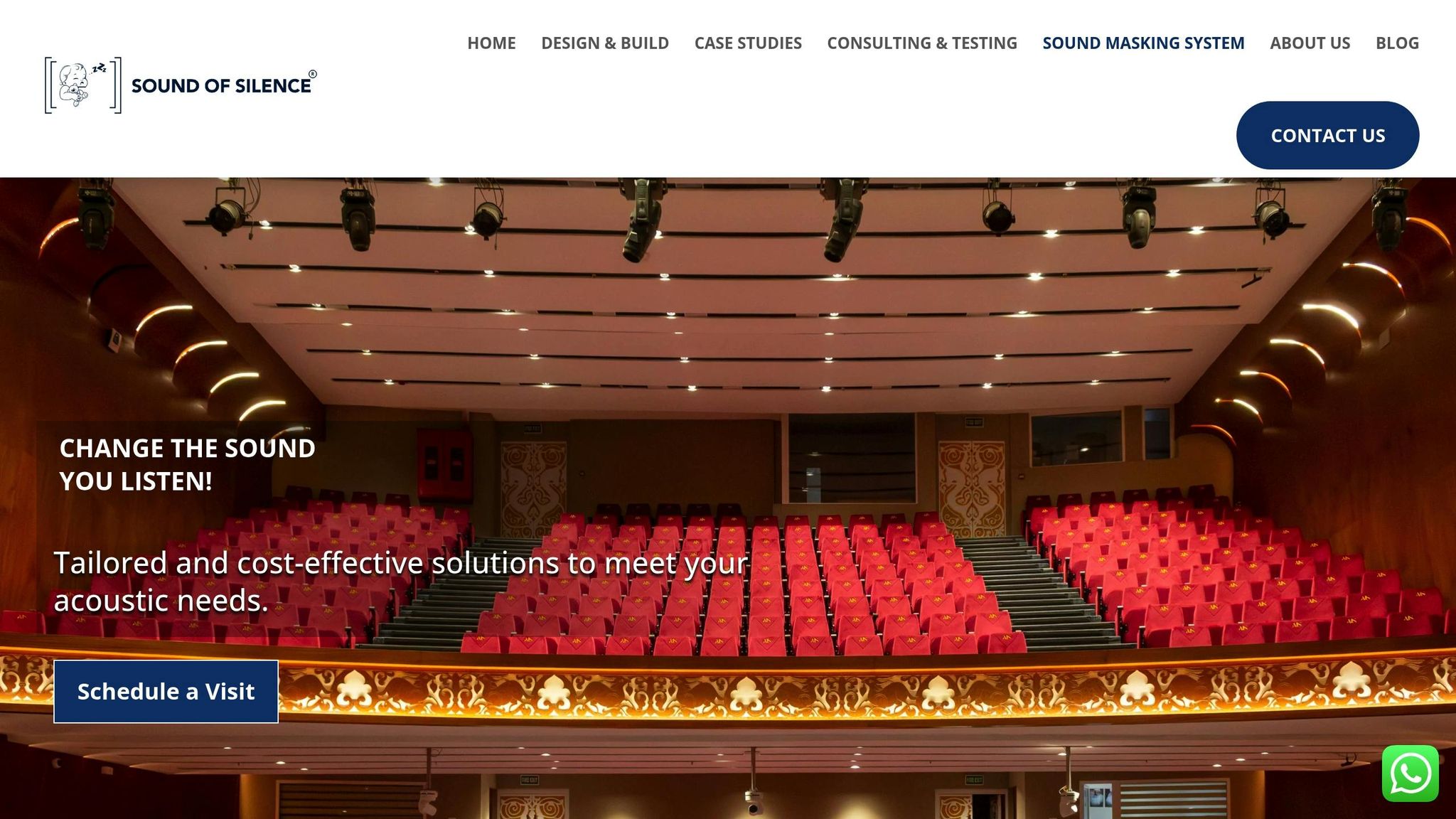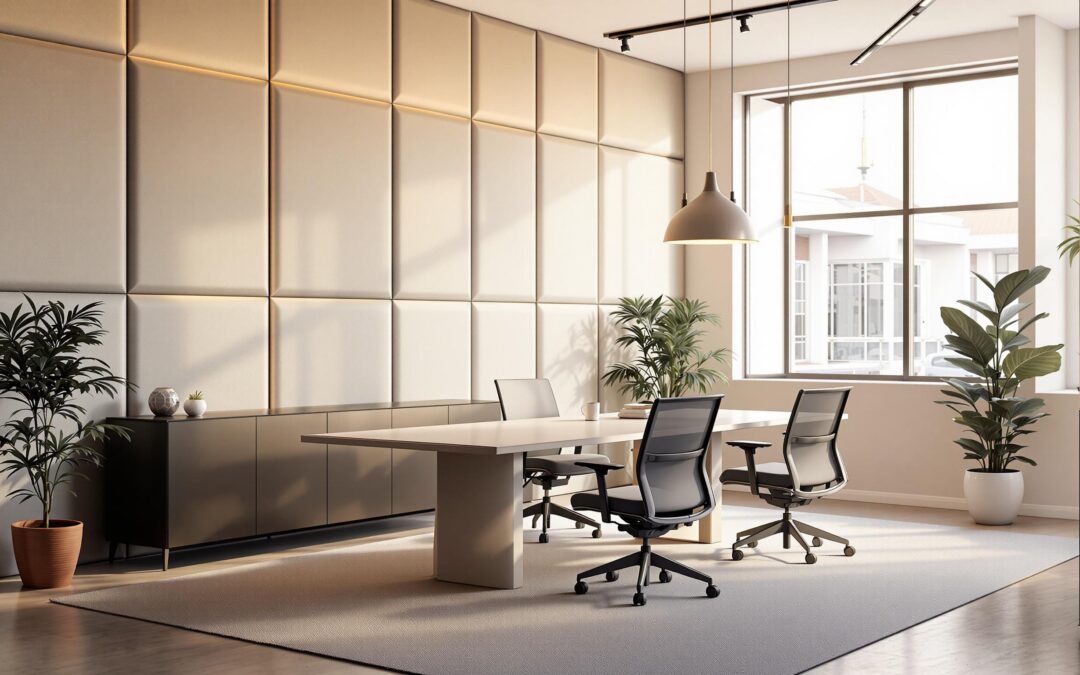Office noise can harm productivity and health. Here’s how to fix it:
- Identify Noise Sources: Common culprits include HVAC systems, office equipment, conversations, and external sounds.
- Measure Noise Levels: Use professional sound mapping or a DIY sound meter.
- Soundproof Key Areas:
- Walls and Ceilings: Use acoustic panels, soundproof paint, or additional drywall.
- Doors and Windows: Install solid-core doors, double-glazed windows, and seal gaps with acoustic caulk.
- Floors: Add rubber underlayments, acoustic carpets, or floating floor systems.
- Choose Effective Materials: Combine sound-blocking (e.g., Mass Loaded Vinyl) and sound-absorbing materials (e.g., acoustic foam).
- Consider Professional Help: Acoustic specialists can tailor solutions to your space and needs.
Quick Comparison of Soundproofing Methods:
| Area | Solution | Cost (£) | Effectiveness | Complexity |
|---|---|---|---|---|
| Walls | Acoustic panels | Moderate | High | Moderate |
| Ceilings | Soundproof tiles | Moderate | High | Moderate |
| Floors | Rubber underlayments | Low | High | Low |
| Windows | Double glazing | High | Very High | High |
Start by addressing the noisiest areas, and layer solutions for the best results. For expert advice, contact acoustic professionals like Sound of Silence.
How to: Soundproofing and Noise Control in Offices and …
Finding Office Noise Problems
Main Office Noise Sources
Office noise can come from a variety of sources, creating an unpleasant environment for employees. Pinpointing these sources is the first step to introducing effective soundproofing solutions.
Here are some common culprits in modern offices:
| Noise Source | Impact Level | Common Issues |
|---|---|---|
| HVAC Systems | Moderate-High | Constant noise from air conditioning and ventilation systems. |
| Office Equipment | Moderate | Mechanical sounds from printers, copiers, and computers. |
| Human Activity | High | Conversations, mobile phone ringtones, footsteps, and group discussions. |
| External Sources | Variable | Traffic, nearby construction, or noise from neighbouring offices. |
Open-plan offices, often designed with minimal partitions and reflective materials like glass, tend to amplify these sounds. Identifying the sources is key to moving forward with precise noise level measurements.
How to Check Sound Levels
Once you’ve identified the sources, the next step is to assess the noise levels in your office. There are two main ways to do this:
-
Professional Sound Mapping
This involves hiring experts to:- Measure sound levels in different areas.
- Identify surfaces that reflect noise.
- Provide detailed acoustic reports tailored to your space.
-
DIY Sound Meters
A sound meter (costing around £300) can help you measure noise levels yourself. However, it won’t provide the in-depth analysis that professionals offer.
As Zigaflow.com explains, "Sound mapping, also known as acoustic mapping, is the process of visualising and measuring sound distribution within a space." [2]
When assessing noise, focus on areas where employees find it hard to concentrate. Research shows that 3 in 10 employees frequently lose focus due to office noise [1], making it a problem worth addressing quickly.
Keep in mind that different parts of the office may need varying levels of soundproofing. Quiet zones and meeting rooms often require stricter noise control compared to communal or reception areas.
Office Soundproofing: Step by Step
Wall and Ceiling Solutions
Reducing noise through walls and ceilings requires careful planning. The key is to add mass and seal any air gaps. Use acoustic sealant (priced around £25 per tube) at wall-ceiling joints, around outlets, cable entries, light fixtures, and HVAC vents. Increasing the mass of walls and ceilings can make a huge difference. Here are some common options:
| Treatment Type | Effectiveness | Installation Complexity |
|---|---|---|
| Acoustic Panels | High | Moderate |
| Soundproof Paint | Moderate | Low |
| Additional Drywall | Very High | High |
| Sound-Absorbing Tiles | High | Moderate |
Once you’ve tackled walls and ceilings, move on to doors and windows, which are often the main culprits for sound leakage.
Door and Window Treatment
Doors and windows are typical problem areas in soundproofing because even tiny gaps can let in a lot of noise.
For doors:
- Replace hollow-core doors with solid-core models.
- Add high-quality door seals and sweeps.
- Install double-door systems in areas where soundproofing is critical.
- Use weatherstripping to seal any remaining gaps.
For windows:
- Install double-glazed units with at least a 25mm air gap [3].
- Seal the edges with acoustic caulk.
- Use neoprene gaskets to separate the glass from the frames.
- Add secondary glazing if needed.
After securing walls, ceilings, doors, and windows, the next step is to address noise coming from the floors.
Floor Noise Reduction
Floor noise, whether from footsteps or furniture movement, can be managed with a combination of approaches to tackle both impact and airborne sounds.
Here are some effective floor treatments:
| Treatment | Primary Benefit | Best Application |
|---|---|---|
| Rubber Underlayment | Impact & Airborne Noise | Under Hard Flooring |
| Sound Isolation Clips | Airborne Noise | Ceiling Treatment |
| Acoustic Carpet | Impact Noise | Direct Installation |
| Floating Floor System | Both Types | New Installations |
For best results, seal floor perimeters with acoustic caulk. While carpets are great for reducing impact noise, they don’t do much for airborne sound. Combining these methods can help create a quieter workspace.
sbb-itb-06ab728
Selecting Soundproofing Materials
Best Materials for Offices
For effective office soundproofing, combine sound-blocking and sound-absorbing materials. Using a mix of Mass Loaded Vinyl (MLV), soundproof drywall, and acoustic sealant creates a strong barrier against noise.
Here’s a quick overview of key materials:
| Material Type | Primary Function | Typical Application | Performance |
|---|---|---|---|
| Mass Loaded Vinyl (MLV) | Sound Blocking | Walls/Ceilings | STC 27 |
| Acoustical Caulk | Gap Sealing | Joints/Seams | Up to STC 53 |
| Sound Barrier Ceiling Tiles | Sound Blocking | Drop Ceilings | – |
| Acoustic Floor Underlayment | Impact Reduction | Under Flooring | Variable |
"Soundproofing is when you use material to block sound from entering or exiting a room, while sound absorption is when you use materials to absorb sound created inside a room in order to create a better-sounding environment." – Acoustical Solutions [4]
If you’re working with a limited budget, there are affordable options that can still deliver solid noise reduction.
Cost-Effective Options
Affordable soundproofing solutions can still provide excellent performance without breaking the bank. For example, SilentCore Acoustic Wall Panels offer different Noise Reduction Coefficient (NRC) ratings based on thickness:
| Panel Thickness | NRC Rating |
|---|---|
| 12.7mm (1/2") | 0.55 |
| 19mm (3/4") | 0.70 |
| 25.4mm (1") | 0.85 |
| 38.1mm (1-1/2") | 0.95 |
Another option is TroyStudio Acoustic Foam Panels, which achieve an NRC rating of 0.8 [6], making them ideal for smaller spaces when placed strategically.
For budget-friendly soundproofing, try these steps:
- Seal gaps: Use acoustic caulk to close joints and seams.
- Add mass: Install acoustic panels to walls.
- Use specialised materials: Whispermat is a cost-effective choice for walls and ceilings [5].
Materials with high NRC and Sound Transmission Class (STC) ratings are generally more effective. For example, Green Glue compound can increase walls or ceilings by up to 9 STC points [7].
Rather than investing in a single expensive solution, combining multiple affordable options often produces better results. Start by addressing the noisiest areas, and expand your efforts as your budget allows.
Working with Sound Experts
Why Use Professional Services
Hiring acoustic specialists brings expertise in testing, planning, and executing soundproofing solutions. They help identify the best options while avoiding costly errors.
These professionals provide detailed technical analysis in areas such as:
- Building structure and materials
- Sound transmission paths
- Room acoustics and reverberation
- External noise sources
- Budget considerations
This thorough approach ensures effective solutions, like those offered by Sound of Silence.
| Benefit | Description | Impact |
|---|---|---|
| Acoustic Testing | Advanced sound measurement methods | Identifies issues with accuracy |
| Tailored Solutions | Customised recommendations | Better noise control |
| Technical Knowledge | Expertise in materials and methods | High-quality implementation |
| Cost Management | Strategic planning and execution | Maximises value for money |
Sound of Silence: Professional Acoustic Services

Services like Sound of Silence follow a structured, step-by-step process to deliver effective acoustic solutions.
1. Initial Assessment
- Comprehensive acoustic testing
- Measuring current noise levels
- Identifying problem areas
2. Custom Planning
- Analysing sound transmission
- Choosing appropriate materials
- Defining installation needs
- Aligning with budget goals
3. Professional Implementation
- Installing acoustic panels and barriers
- Setting up sound masking systems
- Applying vibration control measures
- Using specialised treatments
"Sound of Silence provides tailored and cost-effective solutions to meet specific acoustic needs, ensuring precise and reliable outcomes through expert testing, consulting, and execution services."
Professional acoustic services are ideal for:
- New office fit-outs
- Persistent noise problems
- Meeting specific acoustic standards
- Complex soundproofing projects
- Preserving heritage buildings
Conclusion: Creating a Quiet Office
Key Soundproofing Techniques
To effectively reduce office noise, it’s essential to use a mix of strategies like sound absorption, masking, and physical barriers. Here’s a quick breakdown:
| Technique | What It Does |
|---|---|
| Sound Absorption | Minimises echo and reverberation |
| Sound Masking | Covers up distracting noises |
| Physical Barriers | Blocks direct sound pathways |
These techniques work together to create a workspace that promotes focus and clear communication.
Steps to Start Soundproofing
Ready to tackle office noise? Here’s how to get started:
-
Assess the Noise Problem
- Measure sound levels and pinpoint the main noise sources.
- Note areas where sound issues are most disruptive.
-
Pick Practical Solutions
- Install acoustic panels in key areas like meeting rooms.
- Use thick carpets or rugs to reduce echoes.
- Seal gaps around doors and windows to block external noise.
For expert advice, consider reaching out to Sound of Silence’s acoustic specialists. They can help you make the most of your soundproofing efforts.
Improving office acoustics can lead to better employee focus and smoother collaboration, creating an environment where everyone can thrive.

